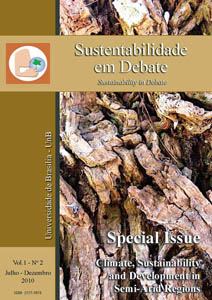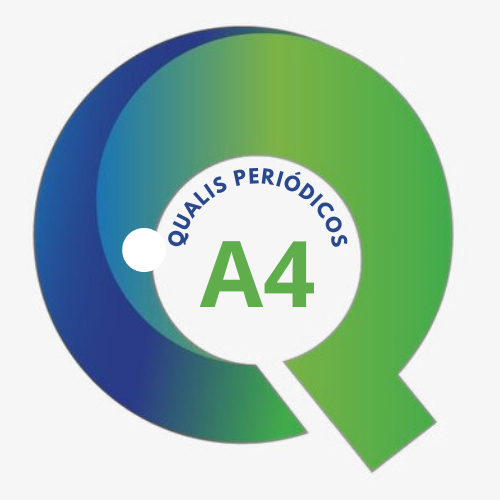Water management strategies in a scarcity situation:
Semi-arid and Mediterranean regions
DOI:
https://doi.org/10.18472/SustDeb.v1n2.2010.1678Keywords:
Semi-arid and Mediterranean climate regions, Water scarcity, Water and ecosystems managementAbstract
At the beginning of the 21st century, the shortage of water is unquestionable constituting a threat to humanity and the biosphere. This situation is experienced in arid, Semi-arid and Mediterranean regions. The management of aquatic resources and the availability of water is a complex issue and of a huge strategic importance for sustainable development. The main objective of this paper is to present and discuss strategies for water management in the Mediterranean and Semi-arid regions through a literature review. As a conclusion, the semi-arid regions, due to its specific characteristics, will suffer more with water scarcity. Regarding the Mediterranean, all scenarios of future developments foresee a decline in rainfall, a trend which will bring serious impacts on society and environment. Hence, Mediterranean regions should focus in implementing simple techniques and lowcost used in semiarid regions, many of which currently abandoned but with centuries-old traditions in the history of the Mediterranean.
Downloads
References
of Mediterranean Ecosystems. In:
Mediterranean Type Ecosystems: Origin and
structure (eds. DI CASTRI, F. & MOONEY,
H.A.). Springer-Verlag, Berlin, pp. 11-19, 1973.
AWERBUCH, L. Status of desalination in
today’s world. In: Desalination and Water Reuse.
(ed. NICKLIN, S.). Leicester, UK,
Wyndeham Press, pp. 9”“12, 2004.
BALLESTERO, E. Inter-BasinWater Transfer
Public Agreements: A Decision Approach to
Quantity and Price. Water Resources
Management 18: 75”“88, 2004.
BATES, B.C.; KUNDZEWICZ, Z.W.; WU, S.;
PALUTIKOF, J.P. Climate Change and Water.
Technical Paper of the Intergovernmental Panel
on Climate Change, IPCC Secretariat, Geneva,
210 pp., 2008.
BEZERRA Sá; GAMA DA SILVA, P. C.
Semiárido brasileiro: pesquisa desenvolvimento
e inovação. Petrolina: Embrapa
Semiárido, 402 pp., 2010.
BRITO L.T.L.; SILVA, A.; MACIEL, J. L.;
MONTEIRO, M.A.R. Barragem subterrânea.
I: construção e manejo. Petrolina: Embrapa-
CPATSA, 1989. 39 pp., 1989.
CALZOLAIO, V. Securing water resources for
water scarce ecosystems. United Nations
Convention to Combat Desertification (UNCCD)
Secretariat, Bonn, 2009.
CARVALHO, R.M.C.; SOBRAL, M. do C.;
COSTA, M.R. da; GUNKEL, G., SILVA, M.M;
LOBO, L. Subsurface dams for water storage
and sustainable development in semi-arid
areas. In: Sustainable Development: Energy,
Environment and Natural Disasters (eds.
DUARTE, L.M.G. & PINTO, P.). Évora, Fundação
Luís de Molina, 147-158, 2009.
CHORUS, I.; BARTRAM, J. Toxic
Cyanobacteria In: Water: a guide to their public
health consequences, monitoring and
management. (eds. CHORUS, I. & BARTRAM,
J.). E& FN Spon, London and New York, 416
pp, 1999.
CROOK, J. Water Reclamation and Reuse
Criteria. In: Wastewater Reclamation and Reuse.
(ed. ASANO, T.). Water Quality Management
Library, Vol. 10, Technomic Publishing, Lancaster
PA, 627-704, 1998.
CUTTELOD, A.; GARCÍA, N.; ABDUL
MALAK, D.; TEMPLE, H.; KATARIYA, V. The
Mediterranean: a biodiversity hotspot under
threat. In: The 2008 Review of The IUCN Red
List of Threatened Species (eds C. HILTONTAYLOR,
J.-C. VIÉ & STUART, S.N.) IUCN
Gland, Switzerland, 2008.
DI CASTRI, F. Mediterranean-type
shrublands of the world. In: Ecosystems of the
World, Vol. 11. Mediterranean Type Shrublands
(eds Castri, F.; Goodall, D. W. & Specht, R. L.),
Elsevier Scientific Publishing Company,
Amsterdam, 1”“52, 1981.
DRECHSEL, P.; SCOTT, C.A.; RASCHIDSALLY,
L.; REDWOOD, M.; BAHRI, A.
Wastewater Irrigation and Health- Assessing
and Mitigating Risk in Low-income
Countries, International Water Management
Institute, Earthscan, London, 404 pp., 2009.
GAO, X.; GIORGI, F. Increased aridity in the
Mediterranean region under greenhouse gas
forcing estimated from high resolution regional
climate projections. Global and Planetary
Change, 62(3-4): 195-209, 2008.
GLEICK, P.H. Water and conflict In: The
World’s Water 1998-1999 (ed. GLEICK, P.M.),
Island Press, Washington DC. Island Press, pp.
105-135, 1998.
GNADLINGER, J. Captação de água de chuva
para uso doméstico e produção de alimentos: a
experiência do estado de Gansu no norte da China,
In: Anais: 3º SIMPÓSIO BRASILEIRO DE CAPTAÇÃO
E MANEJO DE ÁGUA DE CHUVA,
Campina Grande, PB, 2001.
HALLE, S. From Conflict to Peacebuilding ”“
the Role of Natural Resources and the
Environment. United Nations Environment
Programme. Nairobi, Kenya, 44 pp., 2009.
HAUSCHILD, M.; DÖLL, P. Water Use in Semiarid
Northeastern Brazil ”“ Modeling and
Scenario Analysis. Report A0003, Center for
Environmental Systems Research, University of
Kassel, 34109 Kassel, Germany, 2000.
IGLESIAS, A.; GARROTE, L.; FLORES, F.;
MONEO, M. Challenges to Manage the Risk
of Water Scarcity and Climate Change in the
Mediterranean. Water Resources Management,
21(5): 775-788. 2007.
ISAAC, J.; TURTON S. Expansion of the
tropics: Evidence and implications. Cairns:
James Cook University, Australia, 16 pp., 2009.
KUNDZEWICZ, Z.W.; MATA, L.J.; ARNELL,
N.W.; DÖLL, P.; KABAT, P.; JIMÉNEZ, B.;
MILLER, K.A.; OKI, T.; SEN, Z.;
SHIKLOMANOV, I.A. Freshwater resources
and their management. climate change 2007:
Impacts, adaptation and vulnerability.
Contribution of working group II to the fourth
assessment report of the intergovernmental panel
on climate change. Cambridge, UK: Cambridge
University Press, 2007.
LOHMANN, U.; SAUSEN, R.; BENGTSSON,
L.; CUBASCH, U.; PERLWITZ, J.;
ROECKNER E. The Köppen climate
classification as a diagnostic tool for general
circulation models. Climate Research. 3: 177-
193, 1993.
MAHNOT, S.C.; SHARMA, D.C.; MISHRA, A.;
SINGH, P.K.; ROY, K.K. Water Harvesting Management, Practical Guide Series 6, (ed.) V.
Kaul, SDC/Intercooperation Coordination Unit.
Jaipur, India, 2003.
MVUNGI, A.; MASHAURI, D.; MADULU,
N.F. Management of water for irrigation
agriculture in semi-arid areas: Problems and
prospects. Physics and Chemistry of the Earth
30: 809”“817, 2005.
MYERS, N.; MITTERMEIER, R.A.;
MITTERMEIER, C.G.; DA FONSECA, G.A.B.;
KENT., J. Biodiversity hotspots for
conservation priorities. Nature 403: 853-858,
2000.
PANDEY, D.N.; GUPTA, A.K.; ANDERSON,
D.M. Rainwater harvesting as an adaptation
to climate change, Current Science, 85(1): 46”“
59, 2003.
PEREIRA, L.; CORDERY, I.; LACOVIDES, L.
Coping with water scarcity, IHP-VI Tech.
Documents in Hydrology No. 58, UNESCO, 2002.
PEREIRA, L.S.; PAULO, A.A. Droughts:
Concepts, Indices and Predition. In: Water
Management for Drought Mitigation in the
Mediterranean (eds HAMDY, A. & TRISORIOLIUZZI,
G.). Centre International de Hautes
Etudes Agronomiques Méditerranéennes
Tecnomack ”“ Bari, Italy 113-144, 2004.
PITTOCK, B. Climate Change: An Australian
Guide to the Science and Potential Impacts.
Commonwealth of Australia: Australian Greenhouse
Office. 239, 2003.
RABELO L. Estudos preliminares para implantação
da filtração em margem na lagoa do Peri
como pré-tratamento de água para remoção de
fitoplâncton. Tese de Mestrado, Programa de Pós-
Graduação em Engenharia Ambiental. Universidade
Federal de Santa Catarina. Centro Tecnológico,
152 pp, 2006.
RAGAB R.; HAMDY, A. Water Management
Strategies to Combat Drought in the Semiarid
Regions. In: Water Management for Drought
Mitigation in the Mediterranean (eds. HAMDY,
A. & TRISORIO-LIUZZI, G.) (Centre
International de Hautes Etudes Agronomiques
Méditerranéennes) 47-112. Tecnomack ”“ Bari,
Italy, 2004.
SALATI E.; MATTOS DE LEMOS, H.;
SALATI, E. Água e o desenvolvimento sustentável,
pp. 37””62. In: Águas doces no Brasil:
capital ecológico, uso e conservação. (eds.
REBOUÇAS, A.C.; BRAGA, B. & TUNDISI,
J. G.). 3ª edição. Escrituras Editora, S. Paulo,
2006.
SCHIFFLER, M. Perspectives and challenges
for desalination in the 21st century.
Desalination, Vol. 165, pp. 1”“9, 2004.
SCHLESINGER, W.H.; REYNOLDS, J. F.;
CUNNINGHAM, G. L.; HUENNEKE, L. F.;
JARRELL, W. M.; VIRGINIA, R. A.;
WHITFORD, W. G. Biological feedbacks in
global desertification. Science, 247: 1043-1048,
1990.
SENS, M.L.; MONDARDO, R.I.; MELO FILHO,
L.C. Assessing ozonation and riverbank
filtration as pretreatment to direct filtration
for removing cyanobacteria e saxitoxins. In:
Sustainable Development: Energy, Environment
and Natural Disasters (eds. DUARTE, L.M.G.
& PINTO, P.). Évora, Fundação Luís de Molina,
131-146, 2009.
SILVA, A. DS.; PORTO, E. R. Utilização e conservação
dos recursos hídricos em áreas rurais
do trópico semi-árido do Brasil:
tecnologias de baixo custo. Petrolina: Embrapa-
CPATSA, 128 pp., 1982.
SIWI/WHO (Stockholm International Water
Institute/World Health organization). Making
Water a Part of Economic Development, The
Economic Benefi ts of Improved Water
Management and Services. Stockholm/Geneva,2005.
TUNDISI, J.G. Água no século XXI: enfrentando
a escassez. Editora RiMa, IIE.248, 2003.
UN. Water, a shared responsibility. The United
Nations World Water Development. Report - 2.
UNESCO and Berghahn Books, Paris and
London, 2006.
UNDERWOOD, E.; VIERS, J.H.;
KLAUSMEYER, K.R.; COX, R.L.; SHAW,
M.R. Threats and biodiversity in the
mediterranean biome. Diversity and
Distributions 15 (2): 188”“197, 2009.
UNDP. Human Development Report 2006.
Beyond scarcity: Power, poverty and the global
water crisis. United Nations Development
Programme, New York, 422 pp., 2006.
UNESCO. Catch the water ”“ where it drops.
Rain water harvesting and artificial recharge to
ground water. A guide to follow. IHP program
document, 2000
UNITED NATIONS ENVIRONMENT
PROGRAMME (UNEP). UNEP Year Book.
New Science and Developments in our
Changing Environment. 2010. Division of
Early Warning and Assessment (DEWA), Nairobi.
66, 2010.
UN-Water. Coping with water scarcity: a
strategic issue and priority for system-wide
action, 2006.
UN-Water. Coping with water scarcity:
challenge of the twenty ”“ first century, 29 pp.,
2007.
VARGAS-YÁÑEZ, M.; MOYA, F.; TEL, E.;
GARCÍA-MARTÍNEZ, M.C.; GUERBER, E.;
BOURGEON, M. Warming and salting in the
western Mediterranean during the second half
of the 20th century: inconsistencies, unknowns
and the effect of data processing. Scientia Marina.
73(1): 7-28, 2009.
VÖRÖSMARTY, C.J.; GREEN, P.;
SALISBURY, J.; LAMMERS, R.B. Global
Water Resources: Vulnerability from Climate
Change and Population Growth. Science
289(5477): 284 ”“ 288, 2000.
WFD. Water Framework Directive. Directive
2000/60/EC of the European Parliament and of
the Council of 23 October, 2000.
WORLD WATER ASSESSMENT
PROGRAMME (WWAP). The United Nations
World Water Development Report 3: Water in
a Changing World. Paris: Unesco and London.
Earthscan, 2009.
Downloads
Published
How to Cite
Issue
Section
License
Copyright (c) 2010 Sustentabilidade em Debate

This work is licensed under a Creative Commons Attribution-NonCommercial-NoDerivatives 4.0 International License.
SUSTAINABILITY IN DEBATE – Copyright Statement
The submission of original scientific work(s) by the authors, as the copyright holders of the text(s) sent to the journal, under the terms of Law 9.610/98, implies in the concession of copyrights of printed and/or digital publication to the Sustainability in Debate Journal of the article(s) approved for publication purposes, in a single issue of the journal. Furthermore, approved scientific work(s) will be released without any charge, or any kind of copyright reimbursement, through the journal’s website, for reading, printing and/or downloading of the text file, from the date of acceptance for publication purposes. Therefore, the authors, when submitting the article (s) to the journal, and gratuitous assignment of copyrights related to the submitted scientific work, are fully aware that they will not be remunerated for the publication of the article(s) in the journal.
The Sustainability in Debate Journal is licensed under Creative Commons License – Non-Commercial-No-Derivation Attribution (Derivative Work Ban) 3.0 Brazil, aiming at dissemination of scientific knowledge, as indicated on the journal's website, which allows the text to be shared, and be recognized in regards to its authorship and original publication in this journal.
Authors are allowed to sign additional contracts separately, for non-exclusive distribution of the works published in the Sustainability in Debate Journal (for example, in a book chapter), provided that it is expressed the texts were originally published in this journal. Authors are allowed and encouraged to publish and distribute their text online, following publication in Sustainability in Debate (e.g. in institutional repositories or their personal pages). The authors expressly agree to the terms of this Copyright Statement, which will be applied following the submission and publishing by this journal.






